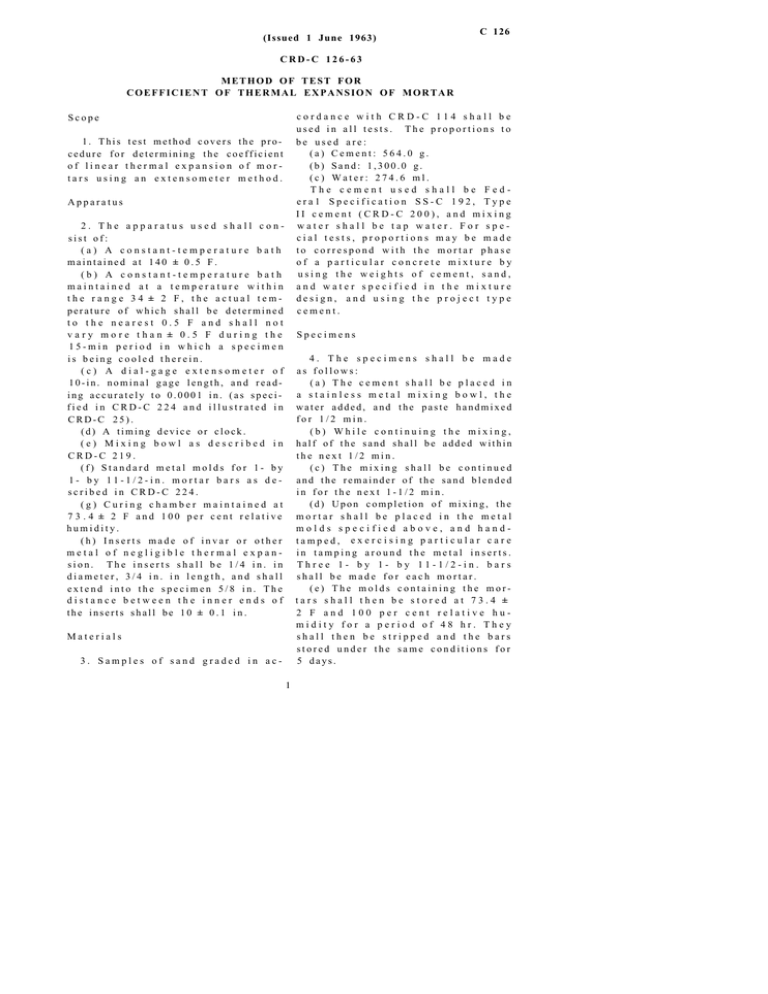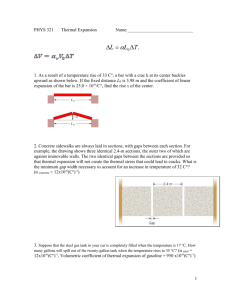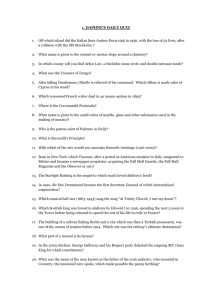C 126
advertisement

(Issued 1 June 1963) C 126 CRD-C 126-63 METHOD OF TEST FOR COEFFICIENT OF THERMAL EXPANSION OF MORTAR cordance with CRD-C 114 shall be used in all tests. The proportions to be used are: (a) Cement: 564.0 g. (b) Sand: 1,300.0 g. (c) Water: 274.6 ml. The cement used shall be Federa1 Specification SS-C 192, Type II cement (CRD-C 200), and mixing water shall be tap water. For special tests, proportions may be made to correspond with the mortar phase of a particular concrete mixture by using the weights of cement, sand, and water specified in the mixture design, and using the project type cement. Scope 1. This test method covers the procedure for determining the coefficient of linear thermal expansion of mortars using an extensometer method. Apparatus 2. The apparatus used shall consist of: (a) A constant-temperature bath maintained at 140 ± 0.5 F. (b) A constant-temperature bath maintained at a temperature within the range 34 ± 2 F, the actual temperature of which shall be determined to the nearest 0.5 F and shall not vary more than ± 0.5 F during the 15-min period in which a specimen is being cooled therein. (c) A dial-gage extensometer of 10-in. nominal gage length, and reading accurately to 0.0001 in. (as specified in CRD-C 224 and illustrated in CRD-C 25). (d) A timing device or clock. (e) Mixing bowl as described in CRD-C 219. (f) Standard metal molds for 1- by 1- by 11-1/2-in. mortar bars as described in CRD-C 224. (g) Curing chamber maintained at 7 3 . 4 ± 2 F and 100 per cent relative humidity. (h) Inserts made of invar or other metal of negligible thermal expansion. The inserts shall be 1/4 in. in diameter, 3/4 in. in length, and shall extend into the specimen 5/8 in. The distance between the inner ends of the inserts shall be 10 ± 0.1 in. Specimens 4. The specimens shall be made as follows: (a) The cement shall be placed in a stainless metal mixing bowl, the water added, and the paste handmixed for 1/2 min. (b) While continuing the mixing, half of the sand shall be added within the next 1/2 min. (c) The mixing shall be continued and the remainder of the sand blended in for the next 1-1/2 min. (d) Upon completion of mixing, the mortar shall be placed in the metal molds specified above, and handtamped, exercising particular care in tamping around the metal inserts. Three 1- by 1- by 11-1/2-in. bars shall be made for each mortar. (e) The molds containing the mortars shall then be stored at 73.4 ± 2 F and 100 per cent relative humidity for a period of 48 hr. They shall then be stripped and the bars stored under the same conditions for 5 days. Materials 3. Samples of sand graded in ac1 (Issued 1 June 1963) 2 COEFFICIENT OF THERMAL EXPANSION OF MORTAR (C 126-63) Test Procedure Calculations 5. The procedures shall be in accordance with the requirements of CRD-C 25. The bars shall be tested at an age of 7 days. They shall be removed from the curing room to a constant-temperature room maintained at 73.4 ± 2 F . They shall then be placed in a constant-temperature bath maintained at 140 ± 0.5 F for a period of 15 min. They shall then be removed individually from the bath and immediately placed in an extensometer. The reading of the dial gage shall be taken within 15 sec after removal from the bath. All bars of a set shall be so tested. They shall then be placed in a constant-temperature b a t h m a i n t a i n e d a t w i t h i n ± 0.5 F of a determined temperature in the range 3 4 ± 2 F for 15 min, at which time they shall be tested in the same manner. The readings shall be taken as quickly as possible to minimize any length change of the extensometer. Repeated cycles of tests shall be performed on all bars to provide at least 6 readings at 140 F and 6 readings at 34 ± 2 F . Readings shall be taken to 0.0001 in. 6. The coefficient of thermal expansion shall be calculated from the readings by the use of the following formula: C = ( RH - Rc ) G T where: C = coefficient of thermal expansion, 10-6 / d e g F , R H = length reading at 140 F, in. x 1 0 - 6, R c = l e n g t h r e a d i n g in the range 34 ± 2 F , i n . x 1 0 - 6, G = axial gage length between inserts (10 in.), and T = difference in temperature. The coefficients so determined shall be averaged for all cycles to give the coefficient of thermal expansion of the mortar bar, and the average of the coefficients for the three individual bars shall be taken as the coefficient of thermal expansion of the mortar, made from the fine aggregate under test.



